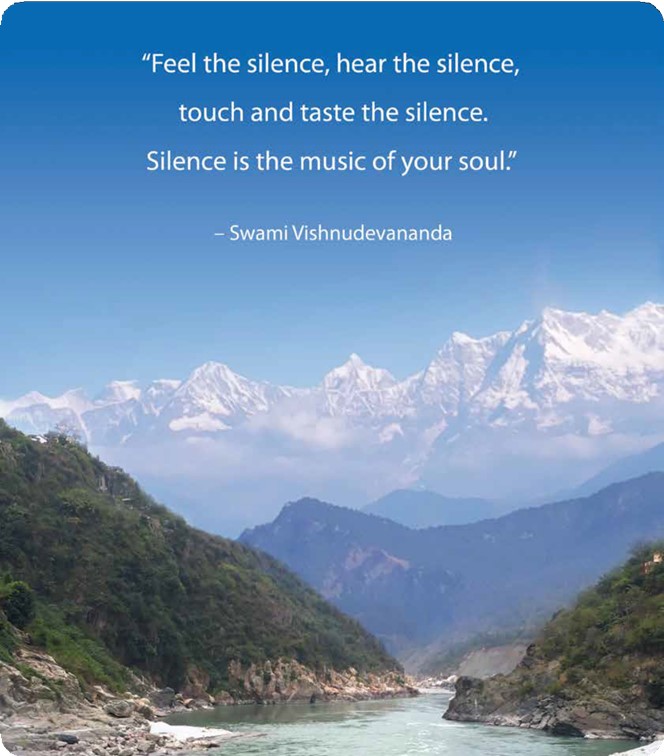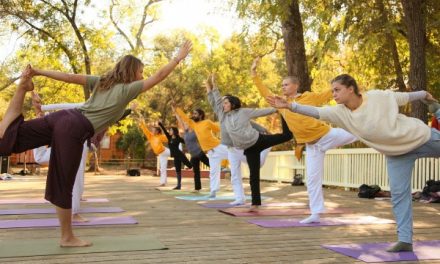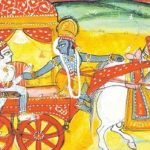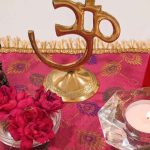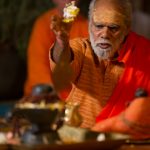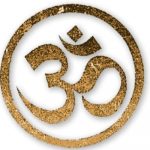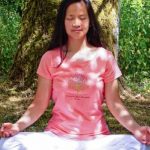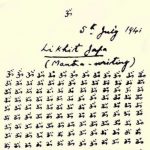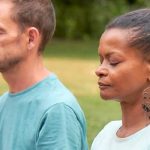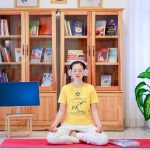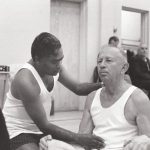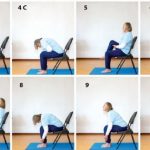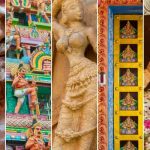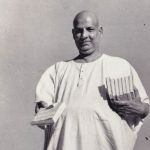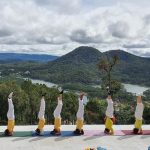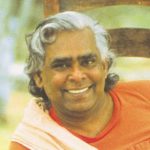 WHO AM I
WHO AM I
PREPARING FOR JNANA YOGA MEDITATION
BY SWAMI VISHNUDEVANANDA
Taken from an initiation lecture given by Swami Vishnudevananda at the start of the Advanced Teachers’ Training Course in Val Morin, Canada in 1982.
When we come to Jnana Yoga meditation we begin with the original knowledge, the knowledge which is held in the Vedas.
It is said that the Vedas came during the previous cosmic night when Brahma was in deep slumber. He himself had been withdrawn by the force of time into the
substratum. That substratum is symbolically represented as the navel of Lord Vishnu.
There, there is a lotus representing the hidden energy, and into that cosmic lotus, the great creator Brahma has been forced to withdraw and rest in deep, deep cosmic sleep – cosmic nidra.
 During that time, all of nature that is made up of the three gunas – sattva, rajas and tamas – is in equilibrium. At that time there is no knowledge: no time, space, or causation. At that time, the Vedas existed only in the memory of the great creator Brahma who is in deep sleep. Just as the knowledge that we have is still there even when we are sleeping although we are not aware of it until we wake up, so it is also with Brahma. We can bring that knowledge only when we are in the waking state. In the deep sleep state whatever knowledge we possess – geometry, philosophy, mathematics, music – all this knowledge is hidden in deep sleep and can only be brought back when we wake from the sleep state.
During that time, all of nature that is made up of the three gunas – sattva, rajas and tamas – is in equilibrium. At that time there is no knowledge: no time, space, or causation. At that time, the Vedas existed only in the memory of the great creator Brahma who is in deep sleep. Just as the knowledge that we have is still there even when we are sleeping although we are not aware of it until we wake up, so it is also with Brahma. We can bring that knowledge only when we are in the waking state. In the deep sleep state whatever knowledge we possess – geometry, philosophy, mathematics, music – all this knowledge is hidden in deep sleep and can only be brought back when we wake from the sleep state.
It was the same with Brahma, too. In the cosmic night everything is in stand-still, like our deep sleep. At least during our deep sleep, others might be in the waking state or in the dreaming state. When we are in darkness, in other parts of the world there is light. That is not the situation here: here
there is no place where there is day or night, time, or space.
There is only stillness, absolute stillness, and as the cosmic night is about to finish its course, at the dawn of the present world Brahma wakes up, just as we are forced to wake up due to our karma. We cannot sleep all day and all night. After several hours we are forced to wake up. It is the same with Brahma also. Due to time, the power of Lord Vishnu, he himself is forced to wake up from his deep cosmic slumber.
At the dawn of the previous cosmic night the forces which were in equilibrium, the three forces of sattva, rajas and tamas are suddenly activated, like a tulip bulb which is activated at the beginning of spring. That tulip bulb was in deep sleep, in a suspended state during the whole winter, but now the energy of the tulip bulb is activated and sends out a small shoot which eventually becomes a tulip flower with colours, beauty and so on.
That hidden nature – Maha Sakti – becomes active, just like the tulip flower becomes active, just like we become active in the morning. The three qualities of nature, sattva, purity; rajas, activity; and tamas, inertia, are no longer in a state of equilibrium and there comes a tremendous oscillation, a vibration, and due to the interaction of these three qualities Sakti is separated and Brahma is able to see the universe yet to come just like in a dream, only in the thought state.
It exists only in the thought state. He exists only in a thought in the universe. He has forgotten the previous creation. He has forgotten everything that he did. Like with amnesia, he has forgotten the past.
Brahma also has cosmic amnesia in the beginning. He doesn’t know what his purpose is, what his duty is, what he is supposed to do. But he sees something – a vague recollection – but still it is not very clear at all. As the Sakti is activated and the intensity increases, he is also having the inner urge to find out, first of all his own substratum, the source from where he has come. He must have a source somewhere. And he looks, and there is only cosmic night – cosmic pralaya.
There is nothing there: neither sun, nor stars, nor galaxies, nor moon, neither up nor down. But he visualises himself seated on a lotus – symbolically representing the energy – and he wants to find out where he has come from, what is his purpose, and what he has to do. He has no idea as Sakti has not completely manifested. Just like someone who has just come out of sleep, he doesn’t know where he is. In that situation Brahma goes on searching his route.
The route is Lord Vishnu, but he doesn’t know. He goes on searching. He goes on to the stalk – symbolically again. For thousands of years he travels, but he still cannot find the beginning. He comes back again and sits in deep meditation and practises pranayama to create the sakti. As he does intense penance and pranayama, then comes the word that he hears in his inner ear, ‘tapah’, ‘penance’. ‘Do penance’.
So he goes on doing penance for thousands of years and then he sees the world yet to come, the type of world he is going to create, just like an architect can see the building that he is going to build. In the same way, in his cosmic mind he sees the cosmic universe, the previous cosmic universe that he created that has now been
dissolved, and the new one which is going to come, what type of manifestation it is going to be.
So from that cosmic vision that he saw from within the substratum he prays to Lord Vishnu, and from that he created the world, and from that the four Vedas came. That is the original knowledge. The Vedas are the original knowledge. From his mouth, the Vedas came, the universe came, and the knowledge came.
So the Vedas were not created, they existed before, just like gravity existed. Gravity was not invented by Newton; it was discovered by Newton. Even before he discovered gravity, gravity was there – he only realised its existence. In the same way the Vedas were there before, but through the mouth of Brahma and through his first initiation into this Vedic knowledge we are able to receive it in this present creation again.
And again this universe will dissolve, and in Brahma’s cosmic night he himself will be withdrawn; all knowledge will be withdrawn back and Brahma will rest again in this cosmic sleep by the force of Vishnu maya – the maya of Lord Vishnu. In this way the universe evolves and dissolves.
We can grasp this concept intellectually by speaking symbolically, but whatever is understood intellectually is not what this cosmic evolution is, this cosmic dawn, this cosmic energy, this sakti maya. The original state is far beyond our comprehension and so we use these simple stories and this symbolic language to understand what the creator and the gunas are.
It can be explained, but still, it is far beyond our comprehension. What is evolution, what is dissolution, what is Brahma, what is the creator, what is Vishnu, what is Sakti is far beyond our understanding.
Vedanta is the last portion of the Vedas and it is here that the knowledge is stored.
Vedanta is the end where there is no more duality. We want to transcend all duality and reach that infinite oneness with the Supreme. So for us, the important question is, ‘Who am I?’. That is Inquiry. The question ‘Who am I?’ is the central question. The next question is, ‘Where do I come from?’. Then, ‘Where do I go?’.
Moksha is freedom from births and deaths.
It is the attainment of eternal bliss. It has neither space nor time in itself; nor is there in it any state, external or internal. You are born to attain moksha or the final emancipation.
Moksha is your goal. Kill this little ‘I’ or egoism through enquiry of Who am I? You will attain moksha and shine as emperor of this world. May you attain moksha in this very birth.
Did this ‘I’ just come now? Did it have any past? Did ‘I’ just come in the middle and does it disappear at the end? If so, then we don’t have to inquire to find ‘Who am I?’. But we all know that this I, this personality, this consciousness in me is not because of the existence of this physical body which I have received from my parents, and which has grown up through the food that I eat – the protein, carbohydrates, and so on.
Is the consciousness this body, or is it something else? Who am I? Am I this body, or something else?
I know that I cannot be this body, this body was not here these many years ago. Before that this physical body, this visible form, wasn’t here. Where was this ‘I’, this
consciousness then? Was this consciousness only created then, at the time of birth or at the time of conception, or was it already there?
This ‘Who am I’ inquiry, these questions, will lead you to find this ‘I’, this pure consciousness that was not born, nor was it the product of any creation, nor did it only exist at a certain time. When did this consciousness come? It was always there and it will always be there in the future when this body drops off.
So inquiry is the main method used in Vedanta philosophy – intellectual inquiry. But it is not a dry intellectual inquiry: there is practical meditation and the student
is readied and prepared through sama (tranquillity of mind), dama (control of the senses) etc. of the Vedantic discipline, like the yama and niyama in Raja Yoga.
Through the service of the teacher, through inquiry, and through discipline, slowly, slowly the disciple is ready to receive this initiation, and at that time, just like one spark will immediately ignite a whole pile of hay, in the same way his whole self is enveloped with this wisdom, this fire of knowledge, ‘I am that I am’ aham Brahmasmi.
At that time when the teacher says, ‘That Thou art’, Tat twam asi, the disciple immediately understands ‘Who am I’: ‘I am not this body, I am Brahman – aham
brahmasmi’. When the teacher says Tat twam asi, the disciple realises aham Brahmasmi.
But before that inquiry, so many disciplines are necessary.
This is the intellectual approach towards this state: Vedanta. Vedanta literally means ‘the end of the Vedas’ because it is based on the teaching of the Upanishads, which form the concluding section of the Vedas.
The Vedas are the most ancient scriptures. Nothing ever came before these Vedas. Their origin is unknown, but it is said that they were given through inspiration to the holy men who sat meditating upon God. From Brahma it came through the line of disciples to our own teachers.
Only Vedanta can give you complete intellectual satisfaction. Other philosophies can give satisfaction to your emotions, or various other aspects of your mind, but Vedanta gives absolute intellectual satisfaction. So there is no other philosophy in this universe that can satisfy the intellect of man, however, not all of us have evolved with a pure intellect. We have reason, but it has been tainted by our emotions and by our understanding of the universe through our own physical senses.
To understand Vedanta you need pure reason. Ordinary reason we use to make a living, to satisfy the senses and to conquer others. That is impure reason. That is associated with emotions, like lust, anger, greed, hatred, jealousy, envy, and fear.
That reason is not sufficient to understand Vedanta. But once that intellect is pure we will be able to understand this philosophy.
And only the true meaning of Vedanta can bring world peace. ‘Love thy neighbour as thyself.’ That subject you see in all. That Self, that Atman alone shines equally. Name and form are false – that is the true experience.
Through the process of discrimination and negation of all that is unreal, name and form is discarded until you reach the point that all that is left is Real: ‘I am That I am’.
The intellect is brought only to that certain extent. This intellect cannot go on forever inquiring ‘Who am I?’ So sit and inquire, ‘I am not this body, this body came from the earth; I am not this mind, this mind is this emotion; I am not this intellect, this intellect is this reasoning; I am not these senses, the senses are only objects. Then, who am I? I am what is left. That is the Self. I am that I am. No more talk, no more inquiry. The intellect also is discarded because the intellect itself is a thought.
By dying you will not be able to reach the Self. By sleeping you will not be able to reach the Self. By dreaming you will not be able to reach the Self. You will be able to understand what the Self is, according to your evolution. So go on, cleaning. If we want to get the experience of the one Self first we have to clean it.
Then go on, slowly, slowly polishing it and as the veils get thinner and thinner there is no more veil and we realise, ‘Oh! I am That I am. I am the universal Self’. I am, and the Universal Self, God, are one. I and my Father are one. I am in you and you are in me. We are one, we are not two. That is Self-realisation. That is the transcendental experience. Everything else – asanas, pranayama, are techniques of how to transcend the veils of the Self.
